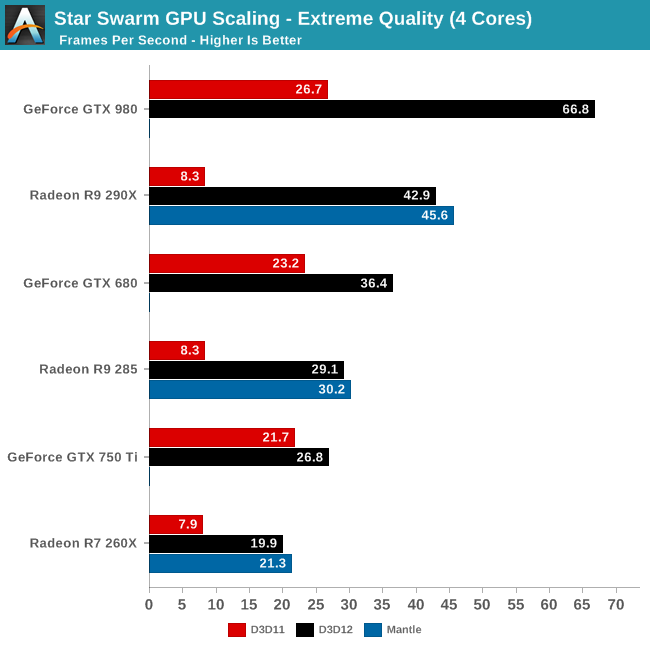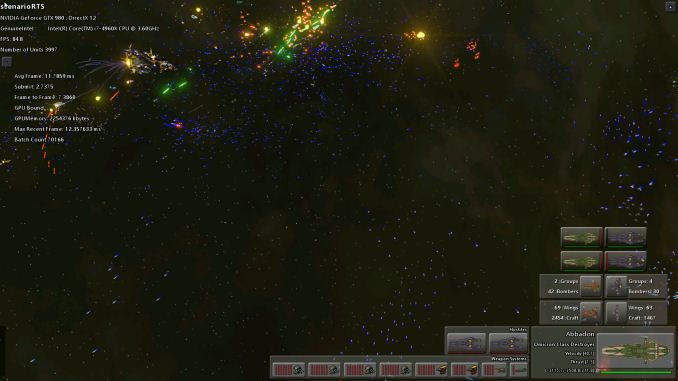The DirectX 12 Performance Preview: AMD, NVIDIA, & Star Swarm
by Ryan Smith on February 6, 2015 2:00 PM EST- Posted in
- GPUs
- AMD
- Microsoft
- NVIDIA
- DirectX 12
Star Swarm & The Test
For today’s DirectX 12 preview, Microsoft and Oxide Games have supplied us with a newer version of Oxide’s Star Swarm demo. Originally released in early 2014 as a demonstration of Oxide’s Nitrous engine and the capabilities of Mantle, Star Swarm is a massive space combat demo that is designed to push the limits of high-level APIs and demonstrate the performance advantages of low-level APIs. Due to its use of thousands of units and other effects that generate a high number of draw calls, Star Swarm can push over 100K draw calls, a massive workload that causes high-level APIs to simply crumple.
Because Star Swarm generates so many draw calls, it is essentially a best-case scenario test for low-level APIs, exploiting the fact that high-level APIs can’t effectively spread out the draw call workload over several CPU threads. As a result the performance gains from DirectX 12 in Star Swarm are going to be much greater than most (if not all) video games, but none the less it’s an effective tool to demonstrate the performance capabilities of DirectX 12 and to showcase how it is capable of better distributing work over multiple CPU threads.
It should be noted that while Star Swarm itself is a synthetic benchmark, the underlying Nitrous engine is relevant and is being used in multiple upcoming games. Stardock is using the Nitrous engine for their forthcoming Star Control game, and Oxide is using the engine for their own game, set to be announced at GDC 2015. So although Star Swarm is still a best case scenario, many of its lessons will be applicable to these future games.
As for the benchmark itself, we should also note that Star Swarm is a non-deterministic simulation. The benchmark is based on having two AI fleets fight each other, and as a result the outcome can differ from run to run. The good news is that although it’s not a deterministic benchmark, the benchmark’s RTS mode is reliable enough to keep the run-to-run variation low enough to produce reasonably consistent results. Among individual runs we’ll still see some fluctuations, while the benchmark will reliably demonstrate larger performance trends.
The Test
For today’s preview Microsoft, NVIDIA, and AMD have provided us with the necessary WDDM 2.0 drivers to enable DirectX 12 under Windows 10. The NVIDIA driver is 349.56 and the AMD driver is 15.200. At this time we do not know when these early WDDM 2.0 drivers will be released to the public, though we would be surprised not to see them released by the time of GDC in early March.
In terms of bugs and other known issues, Microsoft has informed us that there are some known memory and performance regressions in the current WDDM 2.0 path that have since been fixed in interim builds of Windows. In particular the WDDM 2.0 path may see slightly lower performance than the WDDM 1.3 path for older drivers, and there is an issue with memory exhaustion. For this reason Microsoft has suggested that a 3GB card is required to use the Star Swarm DirectX 12 binary, although in our tests we have been able to run it on 2GB cards seemingly without issue. Meanwhile DirectX 11 deferred context support is currently broken in the combination of Star Swarm and NVIDIA's drivers, causing Star Swarm to immediately crash, so these results are with D3D 11 deferred contexts disabled.
For today’s article we are looking at a small range of cards from both AMD and NVIDIA to showcase both performance and compatibility. For NVIDIA we are looking at the GTX 980 (Maxwell 2), GTX 750 Ti (Maxwell 1), and GTX 680 (Kepler). For AMD we are looking at the R9 290X (GCN 1.1), R9 285 (GCN 1.2), and R9 260X (GCN 1.1). As we mentioned earlier support for Fermi and GCN 1.0 cards will be forthcoming in future drivers.
Meanwhile on the CPU front, to showcase the performance scaling of Direct3D we are running the bulk of our tests on our GPU testbed with 3 different settings to roughly emulate high-end Core i7 (6 cores), i5 (4 cores), and i3 (2 cores) processors. Unfortunately we cannot control for our 4960X’s L3 cache size, however that should not be a significant factor in these benchmarks.
| DirectX 12 Preview CPU Configurations (i7-4960X) | |||
| Configuration | Emulating | ||
| 6C/12T @ 4.2GHz | Overclocked Core i7 | ||
| 4C/4T @ 3.8GHz | Core i5-4670K | ||
| 2C/4T @ 3.8GHz | Core i3-4370 | ||
Though not included in this preview, AMD’s recent APUs should slot between the 2 and 4 core options thanks to the design of AMD’s CPU modules.
| CPU: | Intel Core i7-4960X @ 4.2GHz |
| Motherboard: | ASRock Fatal1ty X79 Professional |
| Power Supply: | Corsair AX1200i |
| Hard Disk: | Samsung SSD 840 EVO (750GB) |
| Memory: | G.Skill RipjawZ DDR3-1866 4 x 8GB (9-10-9-26) |
| Case: | NZXT Phantom 630 Windowed Edition |
| Monitor: | Asus PQ321 |
| Video Cards: | AMD Radeon R9 290X AMD Radeon R9 285 AMD Radeon R7 260X NVIDIA GeForce GTX 980 NVIDIA GeForce GTX 750 Ti NVIDIA GeForce GTX 680 |
| Video Drivers: | NVIDIA Release 349.56 Beta AMD Catalyst 15.200 Beta |
| OS: | Windows 10 Technical Preview 2 (Build 9926) |
Finally, while we’re going to take a systematic look at DirectX 12 from both a CPU standpoint and a GPU standpoint, we may as well answer the first question on everyone’s mind: does DirectX 12 work as advertised? The short answer: a resounding yes.












245 Comments
View All Comments
nikon133 - Sunday, February 8, 2015 - link
Windows Mobile was very strong smartphone/PDA OS, back in the pre iOS/Android days. I don't remember how it compared to Symbian, but I do remember that it overtook Palm (marketshare wise) at some point.Tablets, true... unless OP considers PDAs an early tablets.
sr1030nx - Sunday, February 8, 2015 - link
Win10 (and 8.1 to a very limited extent) uses universal apps, meaning you write an app once and it works across PC, tablet and phones.Also means you only need to buy an app once and you get it everywhere.
Christopher1 - Sunday, February 8, 2015 - link
The only person who is wrong here is you, hwangeruk. There are numerous people who have had that the whole "Free upgrade to Windows 10 from 7 and 8!" is directly due to Microsoft wanting to encourage people to not stay on old code and move to new, safer and faster code.pixelstuff - Sunday, February 8, 2015 - link
Windows 8 is not old code by any stretch. I think hwangeruk was right. Microsoft wants all Windows 8 users and especially Windows 7 users to upgrade so they can all run the unified apps that will also run on Windows Phone 10 devices. Microsoft eventually wants all developers writing Windows 10 apps even for things like Photoshop and Illustrator. To make that feasible Microsoft really needs to upgrade the majority of their user base.domboy - Monday, February 9, 2015 - link
But even if they do get everybody to upgrade to 10, that still doesn't guarantee developers are going to switch to the store model, especially the big ones as they'd have to start giving Microsoft a cut of their profits. Same for game developers... Steam is pretty well established at this point. I will probably upgrade since it's free, but really only so I don't get locked out of DirectX 12....Naqoyqatsi - Monday, February 9, 2015 - link
"In that scenario, you are the product."No, you are the laborer.
Frenetic Pony - Sunday, February 8, 2015 - link
I suppose you only use iOS and OSX then as Chrome OS, Linux, and Android are also free?SparkySamza - Tuesday, February 10, 2015 - link
as the saying i hear still now and when i was a child " there is no such thing as a free lunch" i know microsoft has done something, from gathering data via the operating system or even maybe filling it with micro transactions or even forcing people to use xbox everything even though pc people want to be as far away from xbox as they can.Cygni - Friday, February 6, 2015 - link
This is a great way to ensure that developers are forced to continue coding for DX11, or just switch to Mantle. Windows 7 is going to continue to be the dominant OS long into the future.Viewgamer - Friday, February 6, 2015 - link
I'm sorry but does no one find it suspicious that a supposedly "165W" GTX 980 consumes only 14W less than the "290W" R9 290X in DX12 ? and 19W less in DX11.No matter how you slice it, it's abundantly clear that the 165W power figure from Nvidia is pure PR fabrication. Just like the fabricated specs for the GTX 970.